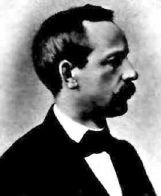

Elwin Christoffel attended an elementary school in Montjoie, but then spent a number of years being tutored at home in languages, mathematics and classics. He attended secondary schools from 1844 until 1849. At first he studied at the Jesuit Gymnasium in Cologne but moved to the Friedrich-Wilhelms Gymnasium. He was awarded the final school certificate with a distinction in 1849. He studied at the University of Berlin from 1850, where he was taught by Borchardt, Eisenstein, Joachimsthal, Steiner and Dirichlet. It was Dirichlet who had the greatest influence on him, and Christoffel is rightly thought of as a student of Dirichlet's.
After a year of military service, he returned to Berlin to study for his doctorate, which he was awarded in 1856 with a dissertation on the motion of electricity in homogeneous bodies.
At this point Christoffel spent 3 years outside the academic world. He returned to Montjoie where his mother was in poor health, but read widely from
the works of Dirichlet, Riemann and Cauchy. It was during this time that he published his first 2 papers. These papers, which appeared in 1858, are on numerical integration. He generalised Gauss's method of quadrature and expressed the polynomials which are involved as a determinant. This is now called Christoffel's theorem.
In 1859, Christoffel took the qualifying examination to become a university teacher and was appointed a lecturer at the University of Berlin. In 1862 he was appointed to the chair at the Polytechnicum in Zurich, filling Dedekind's post. Christoffel was to have a huge influence on mathematics at the Polytechnicum, setting up an institute for mathematics and the natural sciences there.
In 1868, Christoffel was offered a chair at the Gewerbsakademie in Berlin. He and his colleague Aronhold tried to attract high quality students to the Gewerbsakademie, but this proved difficult with the highly prestigious University of Berlin with Weierstrass, Kummer and
Kronecker close by.
After 3 years there, Christoffel was offered the chair of mathematics at the University of Strasbourg. From his appointment in 1872, Christoffel began to build up a new Institute for mathematics. He was assisted in his efforts to build this new highly successful department by his colleague Reye. Christoffel was to hold this chair until he was forced to retire due to ill health in 1892. Christoffel supervised six doctoral students while at Strasbourg. At least four of these were to become university professors of mathematics, including Paul Epstein.
Christoffel published papers on function theory including conformal mappings, geometry and tensor analysis, Riemann's o-function, the theory of invariants, orthogonal polynomials and continued fractions, differential equations and potential theory, light, and shock waves.
Some of Christoffel's early work was on conformal mappings of a simply connected region bounded by polygons onto a circle. This work on conformal mappings was published in 4 papers between 1868 and 1870. Between 1865 and 1871, Christoffel also published 4 important papers on potential theory, 3 of them dealing with the Dirichlet problem. In 1877, Christoffel published a paper on the propagation of plane waves in media with a surface discontinuity. This was an early contribution to the theory of shock waves and followed earlier work on one dimensional gas flows by Riemann.
Christoffel was also interested in the theory of invariants, and he wrote 6 papers on this topic. He wrote some important papers which contributed to the development of
the tensor calculus. The Christoffel symbols [i,j,k] which he introduced are fundamental in the study of tensor analysis. The Christoffel reduction theorem solves the local equivalence problem for two quadratic differential forms.
Christoffel wrote 35 papers, but this does not represent the full extent of his mathematical work. Like many others at that time, much of his original research was put into his lecture courses and only through that source was it known. Christoffel was quite a polished teacher.